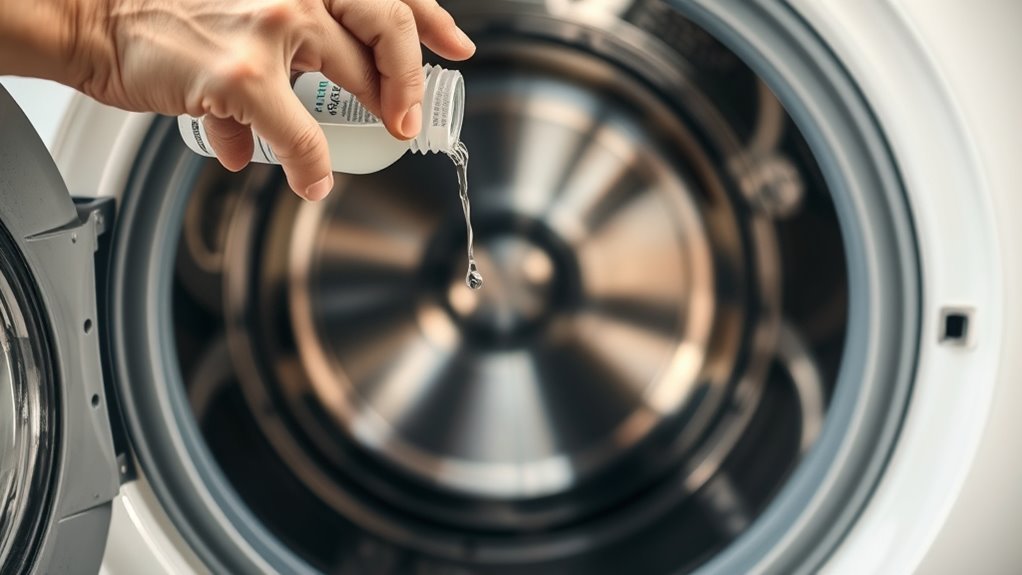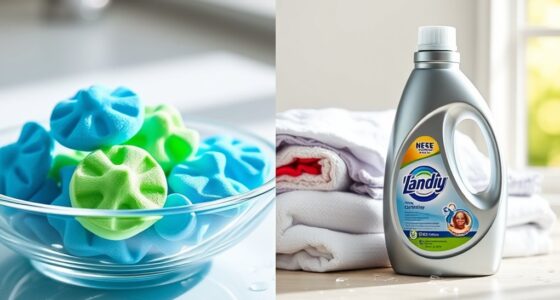To descale your washing machine safely, run an empty hot water cycle with two cups of white vinegar poured into the drum and half a cup of baking soda in the detergent dispenser. This combo helps dissolve mineral deposits and remove buildup from hard water. For ongoing maintenance, regularly clean the detergent drawer and door seals, and consider installing a water softener. Keep exploring for more tips to keep your washer in top shape.
Key Takeaways
- Run an empty hot water cycle with 2 cups of white vinegar to dissolve mineral deposits safely.
- Add half a cup of baking soda to the detergent dispenser to enhance cleaning and deodorizing.
- Avoid using harsh chemicals or abrasive cleaners that could damage internal components.
- Follow manufacturer guidelines for descaling products and avoid overuse to prevent appliance harm.
- Regularly clean detergent dispensers and door seals to prevent residue buildup and maintain efficiency.

Over time, mineral deposits from hard water can build up inside your washing machine, reducing its efficiency and lifespan. This buildup often manifests as detergent residue clinging to the drum and soap dispenser, which can lead to detergent buildup over time. When water hardness is high, minerals like calcium and magnesium settle inside the machine’s components, creating scale that hampers performance. You might notice clothes not coming out as clean or a musty smell developing, both signs that your washer needs a good descaling.
Mineral buildup from hard water reduces washer efficiency, causes detergent residue, and leads to musty odors.
Hard water makes it more difficult for detergents to work effectively because the minerals interfere with the cleaning process. Instead of dissolving properly, soap and detergent residues tend to cling to surfaces, forming a stubborn film that traps dirt and soap scum. Over time, this film becomes thick enough to block water flow and reduce agitation, directly affecting cleaning efficiency. Regularly addressing these issues prevents costly repairs and extends your washer’s lifespan.
To combat this, you should start by running a cleaning cycle with a descaling agent or white vinegar. Before doing so, ensure your washing machine is empty. Pour about two cups of white vinegar directly into the drum and add half a cup of baking soda to the detergent dispenser. Run a hot water cycle, which helps break down mineral deposits and flush out detergent buildup. The acidity of vinegar dissolves mineral deposits caused by water hardness, while baking soda acts as a gentle abrasive and deodorizer. This combination is effective at loosening and removing scale from internal components. Additionally, water quality plays a significant role in preventing future buildup and maintaining appliance performance.
If you prefer commercial descaling products, follow the manufacturer’s instructions carefully. These products are specifically formulated to dissolve mineral buildup without damaging your machine. Regular use—about once a month—can keep mineral deposits at bay and maintain peak washing performance. For areas with very hard water, consider installing a water softener or using a water conditioner to reduce mineral content before it reaches your washer. This proactive step minimizes future buildup and keeps your appliances running smoothly.
Remember to clean the detergent dispenser and door seals regularly, as these areas tend to accumulate detergent residue and mold due to trapped moisture. Wiping down these parts with a vinegar solution or mild cleaner helps prevent detergent buildup and keeps your washing machine smelling fresh. Staying on top of these maintenance tasks ensures your washer remains efficient, cleaning your clothes effectively while avoiding costly repairs caused by scale and detergent residue buildup.
Frequently Asked Questions
Can I Use Vinegar for Descaling Instead of Commercial Products?
Yes, you can use vinegar for descaling instead of commercial products. Vinegar effectiveness as a natural alternative is well-known; it helps break down mineral buildup in your washing machine. Just run a hot cycle with two cups of white vinegar to help remove limescale and residues. While vinegar is safe and eco-friendly, avoid overuse, as it may affect rubber parts. Always follow your appliance’s instructions for best results.
How Often Should I Descale My Washing Machine?
You should descale your washing machine every 1 to 3 months, depending on your water hardness. Regular descaling helps prevent detergent buildup and mold, keeping your machine clean and smelling fresh. If you notice a musty odor or reduced cleaning efficiency, it’s a sign you need to descale sooner. Consistent maintenance ensures your machine runs smoothly, prolongs its lifespan, and maintains peak hygiene.
Are There Specific Descaling Methods for Front-Loading vs. Top-Loading Machines?
You might think front-loading and top-loading machines need different descaling methods, but both benefit from removing detergent residue and maintaining drum cleanliness. While some experts suggest using specific descaling products for each, a simple vinegar and baking soda solution works well for both. Focus on cleaning the drum thoroughly and clearing detergent build-up, regardless of your machine type, to keep it running smoothly and prevent scale buildup.
What Are the Signs That My Washing Machine Needs Descaling?
You’ll notice signs of limescale buildup, like musty odors, longer wash cycles, or clothes not coming out as clean. You might also see soap scum or mineral deposits around the drum or door seal. These issues can reduce laundry efficiency, so if you observe them, it’s time to descale your washing machine. Regular descaling helps maintain peak performance and prevents damage caused by mineral buildup.
Is Descaling Safe for All Washing Machine Brands and Models?
You might think descaling is universally safe, but it’s crucial to check your washer’s brand compatibility first. Some models, especially high-end or sensitive ones, could face descaling risks like damage or voided warranties. Always review your manufacturer’s instructions or consult their guidelines to guarantee the descaling process won’t harm your machine. Following these steps helps you avoid potential issues, keeping your washer running smoothly and safely.
Conclusion
Now that you’ve bravely battled limescale dragons, your washing machine should be gleaming like a knight’s shiny armor. Just picture it: no more grimy buildup lurking like a villain in the shadows, ruining your laundry day. With your trusty descaling ritual complete, your machine’s ready for its next heroic adventure—clean, fresh, and free of villainous deposits. So go ahead, give it a pat on the drum; victory never looked so sparkling!









